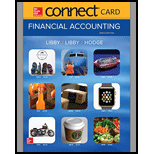
Connect Access Card for Financial Accounting
9th Edition
ISBN: 9781259738678
Author: Robert Libby, Patricia Libby, Frank Hodge Ch
Publisher: McGraw-Hill Education
expand_more
expand_more
format_list_bulleted
Question
Chapter 3, Problem 3.6AP
1 and 2
To determine
Prepare the T- account and enter the transaction into their respective accounts for calculating the ending balance.
3.
To determine
Prepare an income statement for the month January.
4.
To determine
Compute the net profit margin ratio and based on the result give suggestion to the company.
Expert Solution & Answer
Want to see the full answer?
Check out a sample textbook solution
Students have asked these similar questions
Please provide the correct answer to this general accounting problem using valid calculations.
Determine the materials price variance.
I am looking for the correct answer to this general accounting question with appropriate explanations.
Chapter 3 Solutions
Connect Access Card for Financial Accounting
Ch. 3 - Prob. 1QCh. 3 - Prob. 2QCh. 3 - Write the income statement equation and define...Ch. 3 - Explain the difference between a. Revenues and...Ch. 3 - Define accrual accounting and contrast it with...Ch. 3 - Prob. 6QCh. 3 - Explain the expense recognition principle.Ch. 3 - Explain why stockholders equity is increased by...Ch. 3 - Explain why revenues are recorded as credits and...Ch. 3 - Complete the following matrix by entering either...
Ch. 3 - Complete the following matrix by entering either...Ch. 3 - Prob. 12QCh. 3 - State the equation for the net profit margin ratio...Ch. 3 - Which of the following is not a specific account...Ch. 3 - Which of the following is not one of the criteria...Ch. 3 - The expense recognition principle controls a....Ch. 3 - Prob. 4MCQCh. 3 - Prob. 5MCQCh. 3 - Prob. 6MCQCh. 3 - Prob. 7MCQCh. 3 - Prob. 8MCQCh. 3 - Prob. 9MCQCh. 3 - Prob. 10MCQCh. 3 - Prob. 3.1MECh. 3 - Reporting Cash Basis versus Accrual Basis Income...Ch. 3 - Identifying Revenues The following transactions...Ch. 3 - Identifying Expenses The following transactions...Ch. 3 - Prob. 3.5MECh. 3 - Prob. 3.6MECh. 3 - Determining the Financial Statement Effects of...Ch. 3 - Prob. 3.8MECh. 3 - Prob. 3.9MECh. 3 - Identifying the Operating Activities in a...Ch. 3 - Prob. 3.11MECh. 3 - Prob. 3.1ECh. 3 - Reporting Cash Basis versus Accrual Basis Income...Ch. 3 - Identifying Revenues Revenues are normally...Ch. 3 - Identifying Expenses Revenues are normally...Ch. 3 - Prob. 3.5ECh. 3 - Determining Financial Statement Effects of Various...Ch. 3 - Recording Journal Entries Sysco, formed in 1969,...Ch. 3 - Prob. 3.8ECh. 3 - Prob. 3.9ECh. 3 - Analyzing the Effects of Transactions in...Ch. 3 - Preparing an Income Statement Refer to E3-10....Ch. 3 - Prob. 3.12ECh. 3 - Analyzing the Effects of Transactions in...Ch. 3 - Prob. 3.14ECh. 3 - Prob. 3.15ECh. 3 - Prob. 3.16ECh. 3 - Prob. 3.17ECh. 3 - Prob. 3.18ECh. 3 - Prob. 3.19ECh. 3 - Prob. 3.20ECh. 3 - Prob. 3.1PCh. 3 - Recording Journal Entries (AP3-2) Ryan Terlecki...Ch. 3 - Prob. 3.3PCh. 3 - Prob. 3.4PCh. 3 - Prob. 3.5PCh. 3 - Prob. 3.6PCh. 3 - Prob. 3.7PCh. 3 - Recording Nonquantitative Journal Entries (P3-1)...Ch. 3 - Prob. 3.2APCh. 3 - Prob. 3.3APCh. 3 - Prob. 3.4APCh. 3 - Prob. 3.5APCh. 3 - Prob. 3.6APCh. 3 - Accounting for Operating Activities in a New...Ch. 3 - Finding Financial Information Refer to the...Ch. 3 - Finding Financial Information Refer to the...Ch. 3 - Comparing Companies within an Industry Refer to...Ch. 3 - Analyzing a Company over Time Refer to the annual...Ch. 3 - Prob. 3.6CPCh. 3 - Evaluating an Ethical Dilemma Mike Lynch is the...
Knowledge Booster
Similar questions
- Dij, Inc., has current assets of $8,400, net fixed assets of $31,500, current liabilities of $5,900, and long-term debt of $17,200. a. What is the value of the shareholders' equity account for this firm? b. How much is net working capital? HELParrow_forwardI need guidance with this general accounting problem using the right accounting principles.arrow_forwardThe standard cost of Vibrant Sneakers includes 2.5 units of direct materials at $11.50 per unit. During September, the company buys 35,000 units of direct materials at $10.80 and uses those materials to produce 12,800 units. Compute the total, price, and quantity variances for materials.arrow_forward
- Please provide the answer to this financial accounting question using the right approach.arrow_forwardI am looking for help with this general accounting question using proper accounting standards.arrow_forwardexplain properly all the answer for General accounting question Please given fastarrow_forward
- Ironforge Manufacturing, Inc., is a company that manufactures industrial equipment. During the year, Ironforge purchased $2,140,000 of direct materials and placed $1,970,000 worth of direct materials into production. Ironforge's beginning balance in the Materials Inventory account was $385,000. What is the ending balance in Ironforge's Materials Inventory account? Right answerarrow_forwardDisney Distributors is preparing its merchandise purchases budget. Budgeted sales are $725,000 for July and $790,000 for August. Cost of goods sold is expected to be 55% of sales. The company's desired ending inventory is 20% of the following month's cost of goods sold. Compute the required purchases for July.arrow_forwardPreston Company sold 5,250 units in November at a price of $78 per unit. The variable cost is $59 per unit. Calculate the total contribution margin. A. $99,750 B. $100,450 C. $309,750 D. $409,500arrow_forward
arrow_back_ios
SEE MORE QUESTIONS
arrow_forward_ios
Recommended textbooks for you
 Managerial Accounting: The Cornerstone of Busines...AccountingISBN:9781337115773Author:Maryanne M. Mowen, Don R. Hansen, Dan L. HeitgerPublisher:Cengage Learning
Managerial Accounting: The Cornerstone of Busines...AccountingISBN:9781337115773Author:Maryanne M. Mowen, Don R. Hansen, Dan L. HeitgerPublisher:Cengage Learning Managerial AccountingAccountingISBN:9781337912020Author:Carl Warren, Ph.d. Cma William B. TaylerPublisher:South-Western College Pub
Managerial AccountingAccountingISBN:9781337912020Author:Carl Warren, Ph.d. Cma William B. TaylerPublisher:South-Western College Pub Financial And Managerial AccountingAccountingISBN:9781337902663Author:WARREN, Carl S.Publisher:Cengage Learning,
Financial And Managerial AccountingAccountingISBN:9781337902663Author:WARREN, Carl S.Publisher:Cengage Learning,

Managerial Accounting: The Cornerstone of Busines...
Accounting
ISBN:9781337115773
Author:Maryanne M. Mowen, Don R. Hansen, Dan L. Heitger
Publisher:Cengage Learning

Managerial Accounting
Accounting
ISBN:9781337912020
Author:Carl Warren, Ph.d. Cma William B. Tayler
Publisher:South-Western College Pub

Financial And Managerial Accounting
Accounting
ISBN:9781337902663
Author:WARREN, Carl S.
Publisher:Cengage Learning,